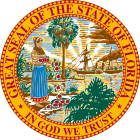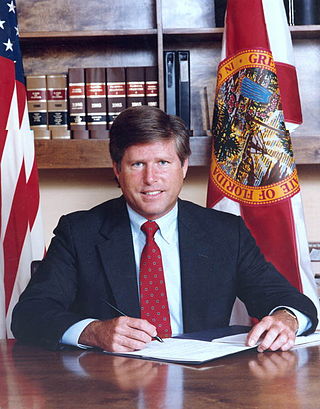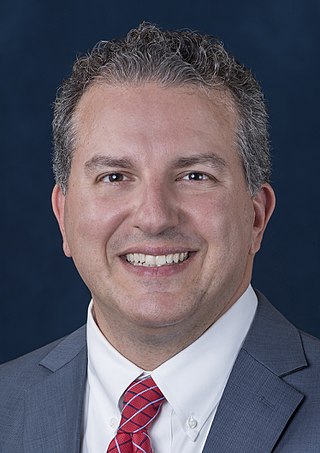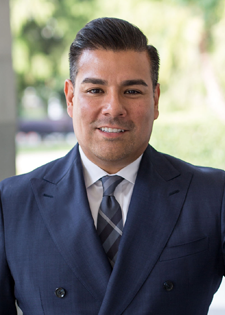 |
|---|
The Florida Cabinet is a body of the government of Florida comprising the attorney general, the commissioner of agriculture, and the chief financial officer that engages in the collective governance of the state.
 |
|---|
The Florida Cabinet is a body of the government of Florida comprising the attorney general, the commissioner of agriculture, and the chief financial officer that engages in the collective governance of the state.
Created following Reconstruction, when there had been a widespread distrust of the governors appointed by the federal government, the cabinet was originally designed to decentralize authority from the governor. Thus, until January 7, 2003, Florida was unique among states in that its cabinet consisted of six independently elected members who each held an equal vote with the state governor in executive decisions. The original Cabinet positions were:
In 1998, Florida voters voted to amend the Florida Constitution to shrink the Cabinet to its current three members. This amendment took effect in 2003, following the 2002 election. Under the reforms adopted, the secretary of state and education commissioner became appointed officials under the governor who would oversee their respective agencies, while the positions of the comptroller and the treasurer/insurance commissioner/fire marshal were combined into the new position of the chief financial officer of Florida. The Cabinet also lost its control over the Florida Department of Education: management of K–12 education and community college education which was shifted to the new Florida Board of Education and management of the State University System of Florida to the new Florida Board of Governors. Some environmental policy powers of the Cabinet were shifted to other officials as well. The reforms were seen as ways to strengthen the power of the governor.
The meetings of the Cabinet are chaired by the governor, currently Ron DeSantis, and include these officers:
Each member is popularly elected statewide and carries one vote in executive decisions. In the case of a tie, the vote cast by the governor decides the outcome. [1]
The governor and Cabinet serves as the board of directors of several state agencies and during their bi-weekly meetings discuss agency business and make policy decisions for the agencies. The governor and Cabinet, all statewide officials, also oversee the separate offices and agencies under their departments. The governor and Cabinet oversees the following agencies:
The governor and each member of the Cabinet has an office dedicated to Cabinet affairs. These offices are headed by a chief Cabinet aide, who is assisted by other aides. The week prior to a Cabinet meeting, the Cabinet aides meet to discuss the agenda and to conduct preliminary discussions on a variety of issues slated to come before the full Cabinet. Cabinet aides' meetings are considered[ by whom? ] an important part of the Cabinet process.

The North Carolina Council of State is the collective body of ten elective executive offices in the state government of North Carolina, all of which are established by the state constitution. The Council of State includes the Governor, Lieutenant Governor, Secretary of State, State Auditor, Treasurer, Superintendent of Public Instruction, Attorney General, Commissioner of Agriculture, Commissioner of Labor and Commissioner of Insurance. Together with the North Carolina Cabinet and several independent agencies, the Council of State offices comprise the executive branch of North Carolina's state government.

The government of Maryland is conducted according to the Maryland Constitution. The United States is a federation; consequently, the government of Maryland, like the other 49 state governments, has exclusive authority over matters that lie entirely within the state's borders, except as limited by the Constitution of the United States.

C. Thomas Gallagher III is an American politician, financier, and insurance agent from the state of Florida and a member of the Republican Party. Gallagher holds the distinction of having served more years as an elected state official than any other individual in Florida history. He began his career in the Florida House of Representatives, where he served from 1974 to 1987.

The government of Florida is established and operated according to the Constitution of Florida and is composed of three branches of government: the executive branch consisting of the governor of Florida and the other elected and appointed constitutional officers; the legislative branch, the Florida Legislature, consisting of the Senate and House; and the judicial branch consisting of the Supreme Court of Florida and lower courts. The state also allows direct participation of the electorate by initiative, referendum, and ratification.
The Treasurer/Insurance Commissioner/Fire Marshal is a former statewide constitutional officer of Florida. The office was abolished following the Florida Cabinet reforms of 1998 which took effect in 2003.

The chief financial officer of Florida is an elected statewide constitutional officer of Florida. The office was created in 2002 following the 1998 reforms of the Florida Cabinet. The CFO is a combination of the former offices of comptroller and treasurer/insurance commissioner/fire marshal. The office heads the Florida Department of Financial Services and is responsible for overseeing the state's finances, collecting revenue, paying state bills, auditing state agencies, regulating cemeteries and funerals, and handling fires and arsons. In addition, the CFO has administrative oversight over the offices which handles banking and insurance regulation. The CFO is a member of the Cabinet is third in the line of succession to the office of Governor of Florida.

The Government of Illinois, under Illinois' Constitution, has three branches of government: Executive, Legislative, and Judicial. The State's executive branch is split into several statewide elected offices, with the Governor as chief executive and head of state, and has numerous departments, agencies, boards and commissions. Legislative functions are granted to the General Assembly, a bicameral body consisting of the 118-member House of Representatives and the 59-member Senate. The judiciary is composed of the Supreme Court of Illinois and lower courts.

The Texas Department of Insurance (TDI) regulates insurers and other companies that conduct insurance business in Texas, and assists Texas-based insurance consumers. TDI was founded in 1876 as the Department of Insurance, Statistics and History.

The government of the U.S. State of Oklahoma, established by the Oklahoma Constitution, is a republican democracy modeled after the federal government of the United States. The state government has three branches: the executive, legislative, and judicial. Through a system of separation of powers or "checks and balances," each of these branches has some authority to act on its own, some authority to regulate the other two branches, and has some of its own authority, in turn, regulated by the other branches.

The California executive branch consists of elected officers and other offices and officers. The elected executive officers are:

The New York State Comptroller is an elected constitutional officer of the U.S. state of New York and head of the New York state government's Department of Audit and Control. The New York State Comptroller is the highest-paid state auditor or treasurer in the country. Sixty-one individuals have held the office of State Comptroller since statehood. The incumbent is Thomas DiNapoli, a Democrat.

The government of the U.S. state of Oregon, as prescribed by the Oregon Constitution, is composed of three government branches: the executive, the legislative, and the judicial. These branches operate in a manner similar to that of the federal government of the United States.
The government of Virginia combines the executive, legislative and judicial branches of authority in the Commonwealth of Virginia. The current governor of Virginia is Glenn Youngkin. The State Capitol building in Richmond was designed by Thomas Jefferson, and the cornerstone was laid by Governor Patrick Henry in 1785. Virginia currently functions under the 1971 Constitution of Virginia. It is Virginia's seventh constitution. Under the Constitution, the government is composed of three branches: the legislative, the executive and the judicial.
Michigan has a republican form of government with three branches of government: the executive branch consisting of the Governor of Michigan and the other independently elected constitutional officers; the legislative branch consisting of the House of Representatives and Senate; and the judicial branch consisting of the one court of justice. The state also allows direct participation of the electorate by initiative, referendum, recall, and ratification.

The government of Tennessee is organized under the provisions of the 1870 Constitution of Tennessee, first adopted in 1796. As set forth by the state constitution, Tennessee's government is divided into three branches: executive, judicial, and legislative branches.
The Florida Comptroller was the state comptroller of Florida from 1845 to 2003. The Comptroller was a member of the Florida Cabinet and was elected by the Florida Legislature until 1865, when it became an elected office.

The executive branch of the government of Puerto Rico is responsible for executing the laws of Puerto Rico, as well as causing them to be executed. Article IV of the Constitution of Puerto Rico vests the executive power on the Governor—whom by its nature forms the executive branch.
The University of Central Florida Student Government is the student body government for the University of Central Florida, a metropolitan public research university located in Orlando, Florida, United States. It is the largest Student Government within the state of Florida and one of the largest in the United States. It also often places in the top ten Student Governments nationally for the services and outreach it provides for the students it serves. SG also serves as the liaison between the student body and University Administration. Three branches, an executive, a legislative, and a judicial are governed by the student-adopted Constitution.
In the United States, each state and territory has constitutional officers who lead the state governments of the United States. These officers may be elected or appointed, depending on the position. The number and powers of state constitutional officers varies from state to state, based on the constitution and statutes of each state. State constitutional officers may reside in the executive or legislative branch, while state constitutions also establish the judicial system of the state, including state supreme courts.

Florida Amendment 8 is an amendment to the Florida state constitution that was passed on November 3rd, 1998. This amendment, which had first been put forth by the Florida Constitutional Revision Commission, amended articles 2, 3, 4, 8, 9, 11, and 13 of Florida's state constitution in an attempt to restructure the cabinet.